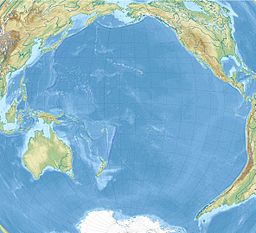| Violet Lake | |
|---|---|
 Violet Lake situated in a forest of ʻōhiʻa lehua trees (
Metrosideros polymorpha) | |
| Location | West Maui Mountains, Maui |
| Coordinates | 20°54′27″N 156°35′41″W / 20.907471°N 156.594779°W |
| Basin countries | United States |
| Surface area | 10 ft × 20 ft (3.0 m × 6.1 m) (approximate) [1] [2] |
| Surface elevation | 5,020 ft (1,530 m) (approximate) [3] [4] |
Violet Lake ( Hawaiian: Kiʻowaiokihawahine), is a small high-elevation lake located at 5,020 ft (1,530 m) above sea level on Mauna Kahalawai (the West Maui Mountains), situated in the western part of the island of Maui. It is located in the boggy slopes near the ʻEke Crater and Puʻu Kukui, the highest peak of the West Maui Mountains. It is approximately 10 ft × 20 ft (3.0 m × 6.1 m) in size. [1] [2]
The lake's English name derive from the reflected color of the lake's surface and also the Maui violet ( Viola mauiensis) which grows on its banks. [5] [6] [7] The Hawaiian language name Kiʻowaiokihawahine means the "pond of Kihawahine". [1] [2] [8] [9]
The lake was important to the traditional Hawaiian religion. During ancient times, the lake and surrounding summit area was protected by kapu and regarded as the meeting place of heaven and earth. [1] [2] The lake was believed to be the home of the Hawaiian moʻo (lizard) goddess Kihawahine, who was associated with the aliʻi nui (high chiefs or kings) of Maui and an ʻaumakua (family deity) of Queen Keōpūolani, a descendant of the Maui royal line and the highest-ranking wife of King Kamehameha I, who established the Kingdom of Hawaii, and their son Kamehameha III. [5] [10] Kihawahine was also associated with the wetland and former royal complex at Mokuʻula located in the watersheds below the lake in Lahaina. [10]
The surrounding montane rainforest ecosystem on the slopes of Puʻu Kukui Watershed Management Area (the second wettest spot in the Hawaiian Islands) is extremely diverse and home to many endemic species. The lake's own unique ecosystem have not been well studied. [5] [11] Species include the dwarfed ʻōhiʻa lehua tree ( Metrosideros polymorpha), the Maui violet (Viola mauiensis), a variety of Hawaiian lobelioids ( Lobelia gloriamontis), the Hawaiian damsel flies ( Megalagrion spp.), and others. [1] [5] It has been described as an "extremely rare gem" which have "residents and visiting scientists alike". [1] [2]
See also
References
- ^ a b c d e f West Maui Mountains Watershed Partnership (2003). West Maui Mountains Watershed Management Plan (PDF). pp. 11–18.
- ^ a b c d e "Rare Ecosystems – Ki'owaiokihawahine (Violet Lake)". West Maui Mountains Watershed Partnership. Retrieved May 27, 2017.
- ^ "Violet Lake". TopoZone. Retrieved May 27, 2017.
- ^ Lloyd J. Soehren (2010). "lookup of Violet Lake". in Hawaiian Place Names. Ulukau, the Hawaiian Electronic Library. Retrieved September 24, 2010.
- ^ a b c d Wianecki, Shannon. "Rooted in Mystery: A Glimpse into Puʻu Kukui, Maui's Protected Native Plant Heaven". Maui Nō Ka ʻOi Magazine. Wailuku.
- ^ Pukui, Mary Kawena; Elbert, Samuel H.; Mookini, Esther T. (1974). Place Names of Hawaii. Honolulu: University of Hawaii Press. p. 217. ISBN 978-0-8248-0524-1. OCLC 1042464.
- ^ MacCaughey, Vaughan (January 1918). Taylor, Norman (ed.). "The Hawaiian Violaceae". Torreya: A Monthly Journal of Botanical Notes and News. XVIII (1): 1–11. JSTOR 40595842. OCLC 5550601940.
- ^ "Hawaii Natural Area Reserves System" (PDF). 2003. Retrieved May 27, 2017.
- ^ Young, Peter T. (February 18, 2015). "Kiowaiokihawahine (Violet Lake)". Image of Old Hawaiʻi. Hoʻokuleana LLC. Retrieved May 27, 2017.
- ^ a b Klieger, P. Christiaan (1998). Mokuʻula: Maui's Sacred Island. Honolulu: Bishop Museum Press. pp. 7–24. ISBN 978-1-58178-002-4. OCLC 40142899.
- ^ Percy, Diana M.; Adam M. Garver; Warren L. Wagner; Helen F. James; Clifford W. Cunningham; Scott E. Miller; Robert C. Fleischer (2008). "Progressive island colonization and ancient origin of Hawaiian Metrosideros (Myrtaceae)" (PDF). Proceedings of the Royal Society B. 275 (1642): 1479–90. doi: 10.1098/rspb.2008.0191. PMC 2602662. PMID 18426752.

